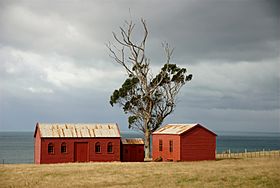Matanaka Farm facts for kids
Quick facts for kids Matanaka Farm |
|
|---|---|

|
|
| Alternative names | Matanaka |
| General information | |
| Type | Farm buildings |
| Address | Private road off Edinburgh Street |
| Town or city | Waikouaiti |
| Country | New Zealand |
| Coordinates | 45°36′29″S 170°42′17″E / 45.6080°S 170.7048°E |
| Construction started | 1840 |
| Renovated | 1977 |
| Owner | New Zealand Historic Places Trust |
| Technical details | |
| Structural system | Timber with galvanised iron roofing |
| Floor count | one |
| Renovating team | |
| Renovating firm | Ministry of Works |
| Designated: | 11 December 2009 |
| Reference #: | 7787 |
Matanaka Farm is a very special place near Waikouaiti in Otago, New Zealand. It has five old buildings that are the oldest farm buildings in the country still standing in their original spots! This amazing farm is looked after by Heritage New Zealand. The buildings are so important that they are officially listed as "Category I," which means they are considered "historically outstanding."
Contents
Exploring Matanaka Farm's Past
How Matanaka Farm Started
Matanaka Farm was created by an Australian whaler named Johnny Jones. He bought the land and a nearby whaling station in 1838. Whalers were people who hunted whales for oil and other products.
In April 1840, Johnny Jones brought about twelve families from Sydney, Australia, on a ship called the Magnet. They came to New Zealand to live and work on the farm.
The very first buildings, including the stables, were built in 1840. The materials for these buildings were brought all the way from Sydney! Records from 1841 mention many barns and places for people to live. This helps historians know how old the buildings are.
Johnny Jones himself moved into the main farm house in 1843. His wife, Sarah Sizemore, was known as Cherry. A nearby place called Cherry Farm is thought to be named after her.
Life on the Farm in the Early Days
When the town of Dunedin started in 1848, Johnny Jones helped the new settlers. He sold them fresh food from his farm at a fair price.
The Jones family moved to Dunedin in 1854. They wanted their children to get a better education there. Johnny Jones's son, William Jones, lived at Matanaka Farm until 1858.
Then, the farm was passed down to the next generation: Johnny Jones's grandson, John Richard Jones, and his wife, Mary Orbell. They lived at Matanaka Farm until 1871. Mary Orbell's brother, McLeod Orbell, then rented the farm until 1878.
New Owners and Protecting History
In February 1878, Matanaka Farm was sold to George McLean. Later, in the late 1880s, McLean leased the farm back to Orbell again.
In 1892, a farmer named Alexander Bannatyne bought the farm. His family owned Matanaka Farm for a very long time, until 1961. After two other people owned it for a short time, Monty Ericson bought the farm in 1965.
The Ericson family did something wonderful for history. In 1976, they gave the Matanaka Farm buildings to the New Zealand Historic Places Trust. This group helps protect important historical sites.
In 1981, the land around the farm buildings was officially made a historic reserve. This means it's a special area protected for its history.
Why Matanaka Farm is Important
The buildings at Matanaka Farm were officially listed as "Category I heritage structures" on December 11, 2009. This listing was done by the New Zealand Historic Places Trust, and its special number is 7787.
The main farm house (homestead) is not part of this special listing and is not open to the public. However, the other farm buildings are incredibly important. They are the oldest farm buildings in New Zealand that are still standing in their original locations! This makes Matanaka Farm a unique and valuable part of New Zealand's history.


